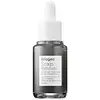What's inside
What's inside
 Key Ingredients
Key Ingredients

 Benefits
Benefits

 Concerns
Concerns

 Ingredients Side-by-side
Ingredients Side-by-side

Water
Skin ConditioningHamamelis Virginiana Water
AstringentAloe Barbadensis Leaf Juice
Skin ConditioningPropanediol
SolventGlycerin
HumectantBiotin
AntiseborrhoeicPanthenol
Skin ConditioningMelaleuca Alternifolia Leaf Oil
AntioxidantCharcoal Powder
AbrasiveMentha Piperita Oil
MaskingZingiber Officinale Root Oil
MaskingMenthyl Lactate
MaskingSaccharide Isomerate
HumectantSodium Hyaluronate
HumectantTocopheryl Acetate
AntioxidantCitric Acid
BufferingHelianthus Annuus Extract
EmollientHeptyl Glucoside
Oryza Sativa Bran Extract
Skin ConditioningPotassium Sorbate
PreservativeRosmarinus Officinalis Leaf Extract
AntimicrobialSodium Hydroxide
BufferingTocopherol
AntioxidantXanthan Gum
EmulsifyingBenzoic Acid
MaskingSodium Citrate
BufferingDehydroacetic Acid
PreservativeBenzyl Alcohol
PerfumingWater, Hamamelis Virginiana Water, Aloe Barbadensis Leaf Juice, Propanediol, Glycerin, Biotin, Panthenol, Melaleuca Alternifolia Leaf Oil, Charcoal Powder, Mentha Piperita Oil, Zingiber Officinale Root Oil, Menthyl Lactate, Saccharide Isomerate, Sodium Hyaluronate, Tocopheryl Acetate, Citric Acid, Helianthus Annuus Extract, Heptyl Glucoside, Oryza Sativa Bran Extract, Potassium Sorbate, Rosmarinus Officinalis Leaf Extract, Sodium Hydroxide, Tocopherol, Xanthan Gum, Benzoic Acid, Sodium Citrate, Dehydroacetic Acid, Benzyl Alcohol
Sucrose
HumectantWater
Skin ConditioningSodium Lauroyl Methyl Isethionate
CleansingGlycerin
HumectantPropanediol
SolventSodium Lauroamphoacetate
CleansingMenthyl Lactate
MaskingGlyceryl Stearate
EmollientPEG-100 Stearate
Silica
AbrasiveCocamide Mipa
EmulsifyingNiacinamide
SmoothingHydrolyzed Yeast Protein
Skin ConditioningZinc Gluconate
Skin ConditioningTocopheryl Acetate
AntioxidantC12-15 Alkyl Benzoate
AntimicrobialParfum
MaskingPhenoxyethanol
PreservativePEG-150 Distearate
EmulsifyingSodium Benzoate
MaskingMenthol
MaskingTrisodium Ethylenediamine Disuccinate
Cetrimonium Chloride
AntimicrobialCaprylyl Glycol
EmollientCitric Acid
BufferingHexyl Cinnamal
PerfumingLimonene
PerfumingLinalool
PerfumingSucrose, Water, Sodium Lauroyl Methyl Isethionate, Glycerin, Propanediol, Sodium Lauroamphoacetate, Menthyl Lactate, Glyceryl Stearate, PEG-100 Stearate, Silica, Cocamide Mipa, Niacinamide, Hydrolyzed Yeast Protein, Zinc Gluconate, Tocopheryl Acetate, C12-15 Alkyl Benzoate, Parfum, Phenoxyethanol, PEG-150 Distearate, Sodium Benzoate, Menthol, Trisodium Ethylenediamine Disuccinate, Cetrimonium Chloride, Caprylyl Glycol, Citric Acid, Hexyl Cinnamal, Limonene, Linalool
Ingredients Explained
These ingredients are found in both products.
Ingredients higher up in an ingredient list are typically present in a larger amount.
Citric Acid is an alpha hydroxy acid (AHA) naturally found in citrus fruits like oranges, lemons, and limes.
Like other AHAs, citric acid can exfoliate skin by breaking down the bonds that hold dead skin cells together. This helps reveal smoother and brighter skin underneath.
However, this exfoliating effect only happens at high concentrations (20%) which can be hard to find in cosmetic products.
Due to this, citric acid is usually included in small amounts as a pH adjuster. This helps keep products slightly more acidic and compatible with skin's natural pH.
In skincare formulas, citric acid can:
While it can provide some skin benefits, research shows lactic acid and glycolic acid are generally more effective and less irritating exfoliants.
Most citric acid used in skincare today is made by fermenting sugars (usually from molasses). This synthetic version is identical to the natural citrus form but easier to stabilize and use in formulations.
Read more about some other popular AHA's here:
Learn more about Citric AcidGlycerin is already naturally found in your skin. It helps moisturize and protect your skin.
A study from 2016 found glycerin to be more effective as a humectant than AHAs and hyaluronic acid.
As a humectant, it helps the skin stay hydrated by pulling moisture to your skin. The low molecular weight of glycerin allows it to pull moisture into the deeper layers of your skin.
Hydrated skin improves your skin barrier; Your skin barrier helps protect against irritants and bacteria.
Glycerin has also been found to have antimicrobial and antiviral properties. Due to these properties, glycerin is often used in wound and burn treatments.
In cosmetics, glycerin is usually derived from plants such as soybean or palm. However, it can also be sourced from animals, such as tallow or animal fat.
This ingredient is organic, colorless, odorless, and non-toxic.
Glycerin is the name for this ingredient in American English. British English uses Glycerol/Glycerine.
Learn more about GlycerinMenthyl lactate is an ester of menthol and lactic acid. It is often used as a cooling agent and fragrance.
When applied topically, this ingredient leaves a refreshing sensation like menthol, but is less irritating.
Propanediol is an all-star ingredient. It softens, hydrates, and smooths the skin.
It’s often used to:
Propanediol is not likely to cause sensitivity and considered safe to use. It is derived from corn or petroleum with a clear color and no scent.
Learn more about PropanediolTocopheryl Acetate is AKA Vitamin E. It is an antioxidant and protects your skin from free radicals. Free radicals damage the skin by breaking down collagen.
One study found using Tocopheryl Acetate with Vitamin C decreased the number of sunburned cells.
Tocopheryl Acetate is commonly found in both skincare and dietary supplements.
Learn more about Tocopheryl AcetateWater. It's the most common cosmetic ingredient of all. You'll usually see it at the top of ingredient lists, meaning that it makes up the largest part of the product.
So why is it so popular? Water most often acts as a solvent - this means that it helps dissolve other ingredients into the formulation.
You'll also recognize water as that liquid we all need to stay alive. If you see this, drink a glass of water. Stay hydrated!
Learn more about Water